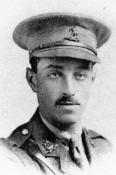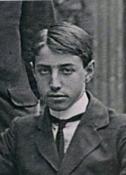
|
The King's School Canterbury |
Roll of Honour |
| Captain Francis Robinson LATTER | |
|
D Company 7th Battalion Queen's Own (Royal West Kent Regiment) Date of birth: 17th November 1894 Date of death: 3rd May 1917 Died of wounds aged 22 Commemorated on the Arras Memorial Bay 7 |

|
| He was born at High Street, Tenterden in Kent on the 17th of November 1894 the second son of Arthur Herbert Latter OKS, solicitor, and Ada Mary (nee Messenger) of the High Street, Tenterden in Kent. He was christened at Tenterden parish church on the 8th of January 1895. He was educated at the Junior King's School from May 1904 and at the King's School Canterbury to April 1912. He was a member of the Officer Training Corps and achieved Certificate A. In 1912 he joined the London County and Westminster Bank where he worked as a clerk. He enlisted at 10 Stone Buildings, Lincolns Inn as Private 749 in the Inns of Court Officer Training Corps on the 1st of December 1913. At a medical examination, which was held on the same day, it was recorded that he was six feet two and half inches tall; he was assigned to A Company. Following the outbreak of war he applied for a commission in the 4th Battalion Queen's Own (Royal West Kent Regiment) (Special Reserve of Officers) on the 8th of August 1914 and was commissioned as a 2nd Lieutenant in the 7th Battalion Queen's Own (Royal West Kent Regiment) on the 3rd of September 1914. He was promoted to Lieutenant on the 9th of November 1914 and to Temporary Captain on the 10th of April 1915. He embarked for France with his battalion from Southampton on board the SS "Mona Queen" at 6.45pm on the 26th of July 1915 and disembarked at Le Havre at 7am the following morning. He was wounded at around 11.30am on the 1st of July 1916 during the battalion's abortive attack at Montauban on the opening day of the Battle of the Somme. He was wounded by a gunshot in the left thigh, was evacuated to No. 2 Red Cross Hospital at Rouen. He was loaded on to the Hospital Ship "St Patrick" at Rouen on the 2nd of July and landed at Southampton on the 3rd of July 1916. A Medical Board was convened at Caxton Hall in London on the 5th of July to consider his case: - "He received a wound of the L. thigh - a bullet entered the outer side of thigh 2" above the knee. The exit wound being 1 1/2" above the other side of knee joint - both wounds septic. both wounds now slightly cleaner - general condition good. X-ray - no bone injury of metal fragments." A Medical Board, which sat at Eastbourne on the 17th of August 1916, pronounced him as being fit for active service and issued orders for him to report to the 9th (Reserve) Battalion of his regiment at Shoreham. On the 31st of August 1916 he received orders to return to France via Folkestone "As soon as possible." On the 3rd of May 1917 Francis Latter was the Officer Commanding D Company, which was to be in reserve for an attack at Cherisy. The village was taken and cleared and the leading companies advanced to the "Blue Line" where their right flank was flung back as the attack by 54th Brigade had failed against the uncut wire and heavy German fire. D Company was designated as "moppers up", to move behind the leading companies and deal with any remaining pockets of resistance. D Company reached the "Blue Line" at 6.15am and they began to consolidate a line on the road leading north east from Cherisy to Vis en Artois. They encountered a number of the enemy in the trench and captured seven of them and a machine gun as well as killing a number of others. They did not remain there long as they were ordered to establish contact with the Buffs and 54th Brigade on their right. This move was carried out by Captain Latter "with much skill and gallantry" though he was wounded during the fighting and could not establish contact with 54th Brigade. The Germans counter attacked on the right of the line, exploiting the gap between the two Brigades "giving Captain Latter and his men good targets in plenty". They drove off the first counterattack with Lewis gun fire but at 6.30am the Germans brought up a machine gun into no man's land which began firing into the Company's rear from the right and before long the "Blue Line" became increasingly untenable, although they are known to have been still holding part of the position at 8.35am. Francis Latter "who was last seen setting a fine example of gallantry and devotion" offered a stout resistance until he and his men were overwhelmed by numbers while holding Bosche Cable Trench. He was wounded and reported missing. The surviving members of the Company were withdrawn at around 9.30am. During this attack the Battalion suffered casualties of twelve officers and three hundred and fifty eight other ranks killed, wounded and missing. Nothing was heard of him until the end of the war when Sergeant G. Wilkins 7th Battalion Queen's Own (Royal West Kent Regiment) returned to England, having been captured during the fighting that day. In a letter dated the 8th of January 1919 he wrote : - "In the attack I was wounded and the same afternoon a German who was standing guard over me pulled a cigarette case out of his pocket which I recognised as belonging to Captain Latter. I asked him where he got it from, he told me from a tall officer, he also took from his pocket a disc which on reading it, I found belonged to Captain Latter. I asked him if the officer was dead and he said "Yes"." The War Office wrote to his father: - "In view of this evidence and also to the length of time since he was reported wounded and missing, the death of the above named officer has now been accepted for official purposes as having occurred on or since 3rd May 1917." His uncle Algernon Latter was Headmaster of the King's School from 1916 to 1927. He is commemorated on the war memorial at Tenterden. |
|
 | |
Back